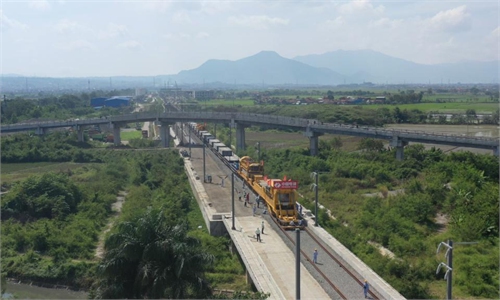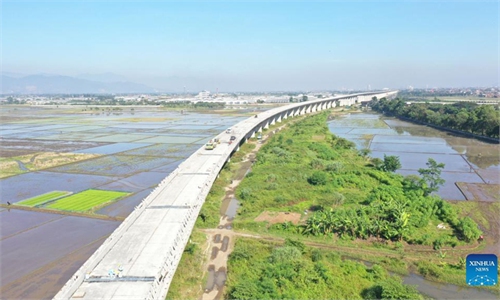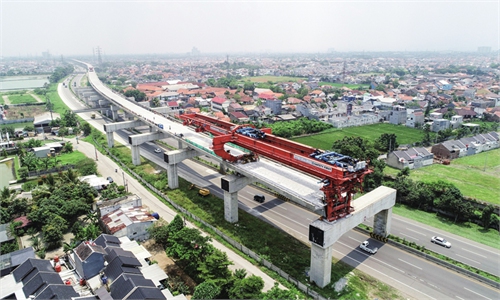Bullet trains designed for 350km/h travel from Jakarta-Bandung roll off assembly line in E.China's Qingdao
First overseas railway project fully uses Chinese tech and standards sets good example
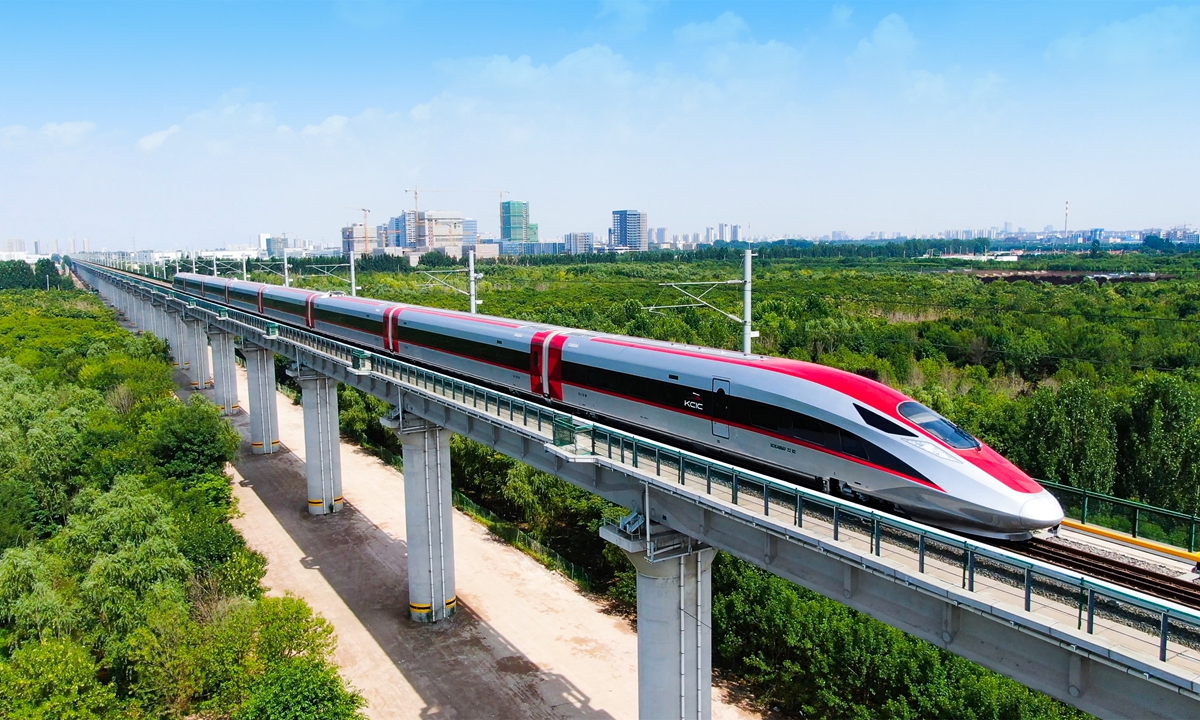
Bullet trains designed for 350km/h travel for Jakarta-Bandung High-Speed Railway roll off assembly line in Qingdao, East China's Shandong Province, on August 5, 2022. Photo: courtesy of China Railway
China's high-speed bullet trains for the 142-kilometer Indonesian Jakarta-Bandung High-Speed Railway (HSR) rolled off the assembly line in Qingdao, East China's Shandong Province on Friday. It is China's first high-speed bullet train export with a top speed of 350 kilometers per hour (km/h).
The Jakarta-Bandung HSR is the first high-speed railway project launched overseas that fully uses Chinese technology, standards and equipment.
It is a landmark project under the China-proposed Belt and Road Initiative (BRI), which sets a good example for Southeast Asian countries, which are potential buyers of China's bullet trains and rail systems, analysts and industry insiders said.
"More countries, especially Southeast Asian countries, may develop their high-speed railways and intercity rail transit with Chinese products, after seeing the examples of the Jakarta-Bandung HSR and the China-Laos Railway," Sun Zhang, a railway expert at Shanghai Tongji University, told the Global Times on Friday.
Eleven pairs of high-speed electric multiple units (EMUs) and one set of comprehensive testing bullet railcars will be shipped to Indonesia very soon, which will lay a solid foundation for the completion of the Jakarta-Bandung HSR as scheduled and high quality, according to a statement sent from China Railway to the Global Times on Friday.
The railway project is expected to be completed in June 2023, the Xinhua News Agency reported. The designed speed of 350 km/h will shorten the travel time between Jakarta and Bandung, the capital of Indonesia's West Java province, from more than three hours to about 40 minutes.
The high-speed EMU and comprehensive test train that rolled off the production line were developed with the advanced and mature technology of the Chinese standard Fuxing EMU at 350 km/h, and adapted to the local operating environment in Indonesia, said a person in charge at China Railway.
The EMU used on the Jakarta-Bandung HSR adopts intelligent sensing technology and is equipped with earthquake monitoring and early warning systems. Through more than 2,500 detection points located along the whole train, all key systems can be monitored and assessed in real time. The EMU also adopts high-standard corrosion-resistant design and advanced protection technology, making it more resistant to salt spray and ultraviolet radiation.
The train can achieve a safe start on a slope of 30 degrees. The train adopts a technology that can regenerate energy from the braking system, which is less carbon-intensive and more energy-efficient.
According to China Railway, the EMU for the Jakarta-Bandung HSR is designed to be capable of carrying 601 passengers, with one first-class car, one dining car and six second-class cars.
CRRC Qingdao Sifang Rolling Stock Research Institute (CRRC SRI) has provided a number of core system products, including a fire monitoring system, an AC/DC insulation monitoring system, the braking system and anti-vibration system, for the EMUs for Jakarta-Bandung HSR, CRRC SRI told the Global Times on Friday.
Smart technology makes fire and smoke monitoring systems smarter. The fire detector is self-learning, and can continuously upgrade itself during operation to make the alarm information more accurate, said CRRC SRI.
According to the institute, relevant parties gathered in Jakarta, Shanghai, Beijing and Qingdao to witness the EMUs rolling off the assembly line by video on Friday.
All the Jakarta-Bandung HSR tunnels have been completed, and more than 90 percent of the subgrade, bridge and station civil works have been completed. Track laying began on the main line in July.
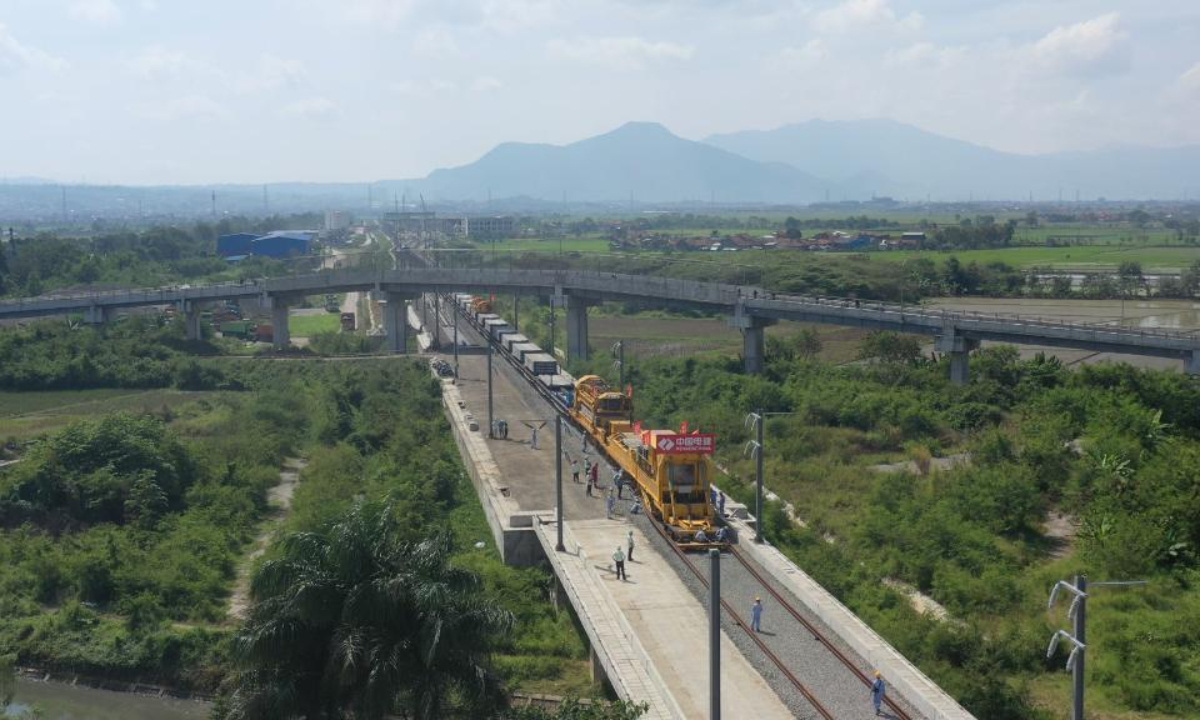
Aerial photo taken on July 1, 2022 shows the construction site of ballasted track laying on Jakarta-Bandung high-speed railway (HSR) main line in Bandung, Indonesia. As the first pair of 500-meter-long rails was slowly pulled out of the transport wagon, the Jakarta-Bandung HSR saw the laying of ballasted tracks begin on its main line, marking the beginning of the online construction stage for the Indonesian railway. Photo:Xinhua
On the main line, the length of the ballasted track section is 112.8 kilometers and that of the ballastless track section is 166.6 kilometers, all of which use 50-meter rails produced in China.
The Jakarta-Bandung HSR is further proof that China's technology and standards for high-speed rail have won international recognition, said Sun, the railway expert.
In July, two international railway standards mainly drafted and developed by China were published by the International Union of Railways. "Design of High-Speed Railways - Infrastructure" and "Design of High-Speed Railways - Power Supply" are both the first international railway standards in their related fields.
The standards introduced China's design concepts based on its global experience in high-speed railway construction, promoted the country's advanced technologies, such as power supply systems, and provided solutions for the design and construction of high-speed railways worldwide, said China State Railway Group.
China's high-speed rail system spans different conditions, including extremely cold weather, frozen soil, mountainous areas, deserts, wet coastal areas and tropical regions, providing rich experience in building high-speed railways worldwide, especially in Southeast Asia, said Sun.
As of the end of 2021, China's high-speed rail service exceeded 40,000 kilometers, accounting for more than two-thirds of the world's total high-speed rail length.
